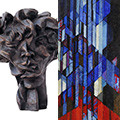František Kupka & Otto Gutfreund
Museum Kampa - Jan and Meda Mládek Foundation, U Sovových mlýnů 2, Praha 1
January 1, 2016 - December 31, 2022
|
František Kupka & Otto GutfreundMuseum Kampa - Jan and Meda Mládek Foundation, U Sovových mlýnů 2, Praha 1January 1, 2016 - December 31, 2022 permanent exhibition Two collections of works by two exceptional artists, František Kupka and Otto Gutfreund, form the foundation of both the Jan and Meda Mládek Collection and the permanent exhibition at Museum Kampa. František Kupka (1871–1957) Since opening in 2003 Museum Kampa has showcased the life and work of František Kupka. Perhaps the most important Czech painter of the 20th century, Kupka spent most of his life in France, but he always maintained contacts with Prague. Museum Kampa has many works by this artist, who had personal ties with the museum’s founder, the patron and collector Meda Mládek. She began regularly visiting Kupka in Paris while she was studying art history at the Sorbonne, and over time she acquired a number of his works, including one of the first two abstract paintings ever exhibited, Amorpha, Warm Chromatic, which was shown at the Autumn Salon in Paris in 1912. At the end of the 1990s Meda Mládek decided to donate her remarkable collection to Prague and exhibit it at Museum Kampa, as she realised the importance of a permanent exhibition for establishing František Kupka’s place in the history of world art. This is also why the museum organises exhibition projects devoted to particular aspects of Kupka’s work. The permanent exhibition presents key paintings from Museum Kampa’s collections and a rotating selection of drawings, and its layout is aligned with whatever temporary exhibition is currently underway. It is divided into several themes. In the first part visitors can see Kupka’s figurative art, especially from 1899 to 1911, which marks the starting point of his journey into non-figurative or abstract art. Among these paintings, Gigolette (Io, La Vache), which looks like it was painted in a single brushstroke, stands out. After moving to a suburb in Paris, Kupka painted working girls, gigolettes and streetwalkers, systematically studying various perspectives and poses: the close-up profile, the half-length figure en face, and the full figure. The next two parts of the exhibition look at how Kupka worked with colour, based on his concept of “colour planes”, which differed from the contemporary Cubist treatment of plane and colour (or rather its absence). Kupka’s use of colour planes allowed him to break up volume in a way that differed from the rules for modelling and deceptive trompe l’œil stereoscopy. Kupka’s work reveals references to his knowledge of contemporary scientific discoveries and technological innovations, such as the influence of the French photographer and filmmaker Étienne-Jules Marey on his art; Marey’s chronophotography guided several works by Kupka, including the Woman Picking Flowers series of watercolours and pastels (1910-1911). The large painting The Fair (1920-1921) was powerfully influenced by the aesthetics of film. The third part shows how Kupka concentrated on questions of point, line and plane. After showing two purely abstract paintings in 1912, Kupka simultaneously developed two approaches: irregular forms and simple geometrical shapes, which was a new aspect in his work so far. In his verticals (the exhibition includes a study for his painting Vertical Planes) the picture space is structured rhythmically and geometrically, resulting almost in a static equilibrium. In contrast the “amorphous” approach further examines the question of motion, point, line and space. Cathedral is a remarkable painting that encapsulates both of these approaches, “where the placing of every tone is manifestly deliberated, and where in the measure of its lightness value each block is a single tone in an orchestral composition.“ (František Kupka, Creation in the Plastic Arts, 1923). Otto Gutfreund (1889–1927) Gutfreund’s work is the most comprehensive developing of Cubism in European sculpture. He first encountered Cubism in its early phase while studying in Paris in 1909-1910. His own art initially became Cubo-Expressionist (Anxiety, 1911; the Concert reliefs and two versions of Head of My Father – Self-Portrait, 1912), in which he worked on a new and dynamic treatment of sculpture, fragmenting the surface into planes and edges. He subsequently worked on Cubist sculpture (Cubist Bust, 1913-1914), a radical way of using sculptural form to activate space. He was the only contemporary sculptor to help develop the metamorphoses of Cubism we find in the work of its principal protagonists, Pablo Picasso and Georges Braque, and he modelled them with a metaphysical dimension that was typical of Central Europe. After fighting in World War One, Gutfreund abandoned questions of Cubist form in favour of figural sculptures in the Civilism style, with simple rounded forms. They helped define a new visual style for the new state of Czechoslovakia, founded in 1918. |


